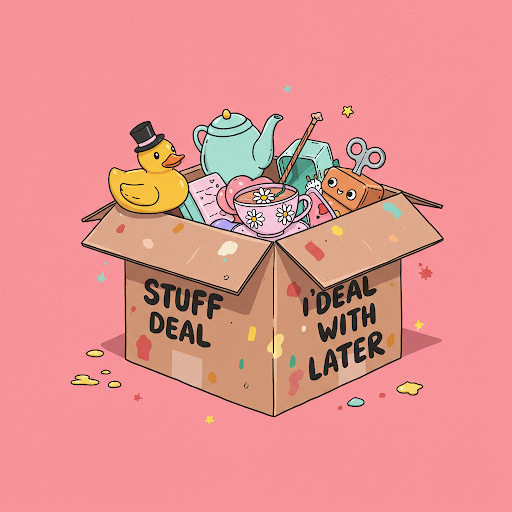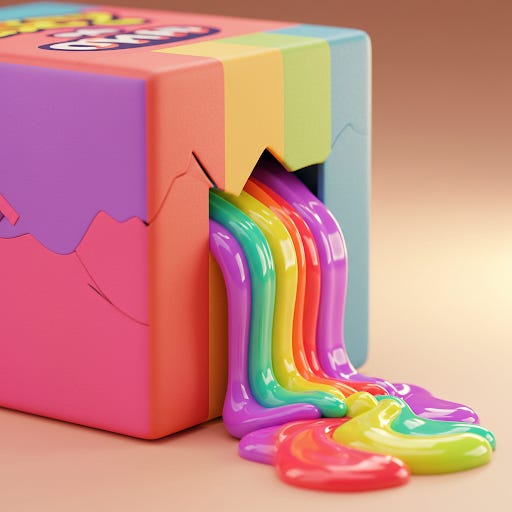Stuff It in a Box: The Perks and Perils of Emotional Tetris
Compartmentalization: A Tool for Balance or a Hidden Burden?
Compartmentalization is a psychological strategy we often use, sometimes without even realizing it. Fancy term, simple idea: it’s what allows you to shelve your emotional baggage temporarily, so you don’t burst into tears during a Zoom meeting. Handy? Yes. Risky if overused? Also, yes. Let’s break it down and sprinkle in some snark for good measure.
What is Compartmentalization? (Besides the Best Trick for Pretending Everything’s Fine)
Compartmentalization is the art of mentally separating different parts of your life. Picture your brain as a neatly organized closet (or a chaotic one if you’re like me on a Tuesday). Work stress stays in one box, personal drama in another, and somewhere in the corner, there’s a box marked “Stuff I’ll Deal With Later (Maybe).”
It’s the psychological equivalent of shoving everything under the bed before company comes over. For example, you’ve had a knock-down, drag-out argument with your partner, but you still need to put on your customer service face and smile like you’re auditioning for a toothpaste commercial. Boom, compartmentalization.
When Compartmentalization is Beneficial (AKA When You Need a Quick Emotional Fire Escape)
Compartmentalization isn’t all bad. In fact, sometimes it’s the only way to keep the wheels turning. Here are some golden examples:
High-Stress Work Environments: Doctors, firefighters, teachers—basically anyone whose job might involve metaphorical (or literal) flames. Keeping your cool by shoving your personal issues into a mental drawer is essential for survival.
Short-Term Focus: Whether you’re prepping for an important presentation or trying not to cry over spilled oat milk, a little compartmentalization can help you keep your eyes on the prize.
Saving Your Relationships (Kind Of): Nobody likes a dinner guest who spends the entire evening complaining about work. Compartmentalization lets you be present in the moment, which is great until your unresolved issues come out swinging later.
So yes, compartmentalization has its perks. But just like eating cheese straight from the block, it’s best enjoyed in moderation.
The Downside of Over-Compartmentalizing (When the Boxes Start Leaking)
Let’s not sugarcoat it—there’s a dark side to all this mental organization. Over-compartmentalizing can turn you into a walking emotional time bomb. Here’s why:
Emotional Suppression: Stuffing emotions into neat little boxes doesn’t make them disappear. It just makes them quietly fester until you explode over something like someone putting the toilet paper on the holder “wrong.”
Fragmented Identity: If you’re constantly switching between different versions of yourself, you might start to feel like an extra in your own life. Where’s the real you? Probably in one of those boxes you forgot to open.
Strained Relationships: Imagine ignoring a dripping faucet. Eventually, that small leak becomes a flood. When unresolved issues pile up, even the most solid relationships can hit rough waters.
Burnout: Shifting gears so often can leave you mentally fried. It’s like trying to drive a car stuck in third gear—sure, you’ll get somewhere, but not without serious wear and tear.
When to Compartmentalize (And When to Let It All Hang Out)
Compartmentalization is a powerful tool when used responsibly. Think of it as the duct tape of your mental health toolbox—great for quick fixes, not for holding the whole thing together. Here are some guidelines:
Short-Term Situations: Got a deadline looming? Fine, pop those personal problems into a box. Just don’t let them collect dust there forever.
Pair It With Processing: At some point, you’ve got to open the box and face what’s inside. Journaling, venting to a friend, or even ugly crying in the shower can all help.
Don’t Use It As a Crutch: Compartmentalization is a temporary fix, not a lifestyle. If you’re constantly boxing up your emotions, it might be time for a reality check (or a therapist).
When NOT to Compartmentalize (Step Away from the Shelf)
There are some situations where compartmentalization is more harmful than helpful:
Avoiding Hard Conversations: Newsflash: ignoring issues doesn’t make them disappear. Shocking, I know. (like avoiding that sink full of dishes.)
Pretending You’re Fine: If your feelings are leaking out in the form of snapping at loved ones or uncontrollable sobbing over coffee commercials, it’s time to stop pretending.
Prolonged Use: Compartmentalization might seem like the easy option, but long-term avoidance often leads to emotional indigestion. (and sometimes literal indigestion, que the heartburn and stomach ache.)
This is your bodies way of saying we have suppressed this enough and it may be time for a good shower cry - read more on that here.
The (Witty) Bottom Line
Compartmentalization is like a good pair of yoga pants—comfortable, flexible, and sometimes essential for surviving the day. But wear them every single day without pause, and you might find yourself questioning life’s choices. (Yes, this is a metaphor for unresolved emotions.)
So, next time you’re tempted to lock your feelings in a mental drawer and throw away the key, ask yourself: Is this a temporary measure, or am I just kicking the can down the emotional road?
Call to Action:
Open up one of those mental boxes this week—you know, the one gathering metaphorical cobwebs. Journal about what’s inside, call a trusted friend, or schedule that therapy session you’ve been avoiding. Share your experience in the comments below. Let’s build a community where we embrace life’s messy, unboxed moments—snark and all.



